Zoanthus sp.
Printed From: Utah Reefs
Category: Specialized Discussion
Forum Name: SPS
Forum Description: This is the place to ask questions SPS corals.
URL: http://www.utahreefs.com/forum/forum_posts.asp?TID=12484
Printed Date: April 26 2025 at 3:42pm
Software Version: Web Wiz Forums 12.03 - http://www.webwizforums.com
Topic: Zoanthus sp.
Posted By: Kyle
Subject: Zoanthus sp.
Date Posted: May 26 2006 at 3:42pm
|
Hey everyone!!! So with all this spare time i get to spend inside this summer i decided i`d like to try and post weekly coral pics and descriptions. Please anyone feel free to add any questions or comments!
So with the first one i decided to stick with something easy and very common. ZOO`S....... Everybody loves zoanthids right? Kingdom: Animalia (animals) Phylum: Cnidaria (cnidarians) Class: Anthozoa (anemones and corals) Subclass: Zoantharia Order: Zoanthidea (zoanthids) Family: Zoanthidae Genus: Zoanthus Species: Zoanthus alderi Species: Zoanthus coppingeri Species: Zoanthus danae Species: Zoanthus mantoni Species: Zoanthus pacificus Species: Zoanthus pulchellus Species: Zoanthus sociatus (green sea mat) Species: Zoanthus solanderi Species: Zoanthus vietnamensis And many others, mostly unclassified 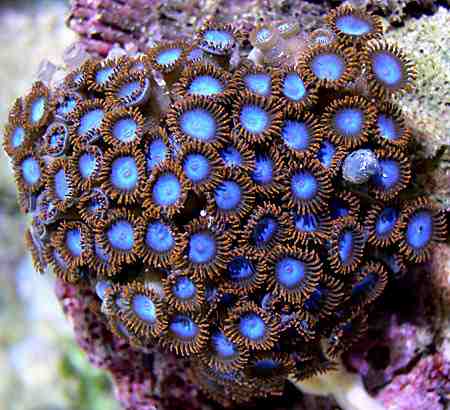 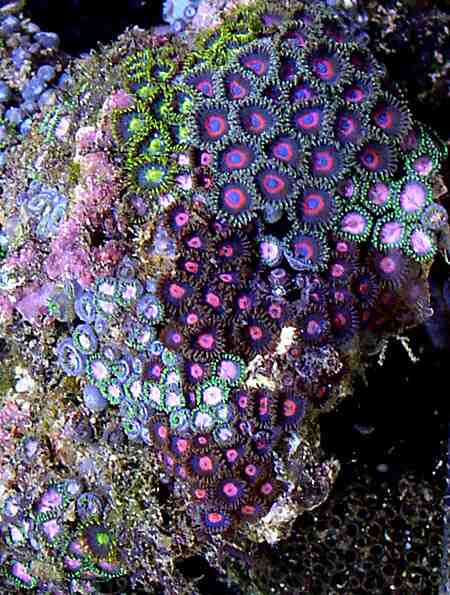
I know I know There more like an anemone than a coral and this should be in the inverts section but i`m going to be posting mostly corals so i think i`ll just keep it here. Zoanthus sp. Common Names: Sea Mat, Button Polyp, Sand Polyp, Polyp Rock, Colonial Anemones Identification: Mat-like colonies of polyps with a fringe of blunt tentacles surrounding the oral disc, in contrasting shades of green, red, orange, pink, and blue. Zoo`s obtain most of there nutrition from there zooxanthellae. Some do, but most do not eat meaty foods (All eat dissolved organic matter). Some eat sea urchin eggs, chopped worms, or finely chopped fish. Zoanthus are very common and fast reproducing colonies throughout various reef zones. Their polyps are rarely larger than 0.5 in. across the oral disc. Zoanthus species normally by buds that are attached at their base to the parent colony. Captive Care: Zoanthus colonies are highly dependent on their zooxanthellae-- rather than active feeding on zooplankton-- for energy, and should always be placed in the aquarium where they will receive bright lighting and ample water flow to help remove debris from inbetween the polyps. Species Info Atlantic and Pacific Species: Zoanthus pacificus: Small to large clumped colonies of short-tentacled polyps that vary in color, usually found in shallow areas with high water movement. The oral disc is often a contrasting lighter color. Zoanthus sociatus: Forms elaborate piecemeal mats of normally green to turquoise polyps. They are often found on reef flats exposed to high light intensity and intermittently strong currents. Stolon-connected polyps normally have 30 short tentacles, polyps are extended continuously day and night and feed predominatly on detritus, not zooplankton. Atlantic Species: Zoanthus pulchellus: Forms an encrusting mat so dense that polyps crowd and press against each other when expanded. Polyps are variable in color (but often brown) and have short, blunt tentacles. When unexpanded, colonies are usually hemispherical and suggest Favia like coral heads. This species is found in variable light and current conditions, with deep-water colonies occasionally fluorescent orange. Zoanthus solanderi: Forms large, dense, fast-growing colonies primarily on reef flats and back-reef areas. Theyare aggresive competitors and are usually able to overgrow nearby sessile life. Pacific Species: Zoanthus coppingeri: Small polyps are not encrusted with sediment, forms large colonies on coral rubble and on colonies of M. digitata, found in bright colors, including orange, red, yellow, and green. Light and current-loving colonies are found on rocky shores and reef flats. Zoanthus mantoni: Dark brown and green, grayish blue, or bright green polyps form a mat that is usually buried in silt and substrate up to the oral disc, and is often found along with Protopalythoa. The oral disc shows white, distinct patterns that can be quite pretty and that contrast with the tentacles. This is a lagoon species that prefers low current and bright light but is very tolerant of varying aquarium conditions. Zoanthus vietnamensis: Forms extensive, sheetlike mauve or blue rubbery, thinly encrusting mats, the polyps are completely buried in the coenenchyme. Numerous short tentacles usually contrast in color with the rest of the colony, light blue or blue green oral discs are common. Found in areas of rough shallow water where it may occur with Palythoa and/or Protopalythoa. Ok thats all i can type in one day. Most of this text is from Eric Borneman`s Aquarium corals book and also Julian Sprung`s invertebrates. Pictures are from my own collection and also Reefermadness.us Let me know what you think or if there are any grammar problems and please POST MORE PICS!!! LET`S SEE EVERYONE`S ZOO COLONIES!!!! |
Replies:
Posted By: Jared Wood
Date Posted: May 26 2006 at 5:49pm
|
We need to start a wiki for utahreefs.com. You've just written the Zoathid article. We could have the best reef wiki on the web
I vote for http://www.utahreefs.com/wiki/ - www.utahreefs.com/wiki/ ------------- In the beginning, God created the heaven and the earth ... then He let it cycle. Have you read my http://www.jaredwood.com/observations.htm#dinosaur" rel="nofollow - dinosaur theory yet? |
Posted By: griffith
Date Posted: May 26 2006 at 8:59pm
|
Nice pics.
Great article.
BTW - I got my Maroon Gold Band Clowns from you guys and love them.
How expensive are the Blue and Pink Zoos?
Linn
|
Posted By: Kyle
Date Posted: May 27 2006 at 10:01am
|
Great Griff! I`m glad you like them!
The Blue zoo`s are a frag from coreyk`s tubbs colony. I only have a small piece myself so i`m going to grow those for a bit before they`ll be ready to frag. The pinks I keep saying i`m going to frag "today" so maybe today if i can get some help. When there fraged out i`ll let you know if there are any available pieces left, I`ve already got a list of people that want those but i`ll put you in line if you want? |
Posted By: Kyle
Date Posted: May 27 2006 at 1:13pm
For some reason i can`t get these back up with the orignal post so here`s some more pics
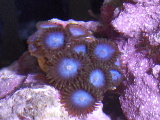 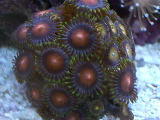  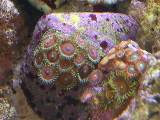 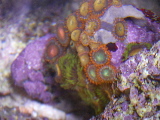
|
Posted By: Kyle
Date Posted: May 28 2006 at 10:51am
| By the way what`s a wiki? |
Posted By: Shane H
Date Posted: May 31 2006 at 8:55am
| Anyone else have zoanthid pics to share? |
Posted By: Jake Pehrson
Date Posted: May 31 2006 at 12:17pm
|
I started a "aquatic database" about 5-6 years ago. It started out as a Cnidaria database. I then started a fish database. Unfortuantly is was impossible for one person to keep up with the information so I recently updated it to the "wiki" format. It can be found at http://www.aquaticdatabase.com - www.aquaticdatabase.com You can check out some page examples here: Fish: http://aquaticdatabase.com/wiki/index.php/Amphiprion_ocellaris - http://aquaticdatabase.com/wiki/index.php/Amphiprion_ocellaris http://aquaticdatabase.com/wiki/index.php/Zebrasoma_flavescens - http://aquaticdatabase.com/wiki/index.php/Zebrasoma_flavescens Corals: http://aquaticdatabase.com/wiki/index.php/Plerogyra - http://aquaticdatabase.com/wiki/index.php/Plerogyra http://aquaticdatabase.com/wiki/index.php/Xenia_elongata - http://aquaticdatabase.com/wiki/index.php/Xenia_elongata Terms: http://aquaticdatabase.com/wiki/index.php/Category:Term - http://aquaticdatabase.com/wiki/index.php/Category:Term Unfortunately the old database information could not be
easily converted to the new wiki format so content is limited right now.
Most of the work in the new wiki format has been spent creating
templates and entering terms. These will allow a consistent look across the web site and
also allows neat features like taxonomy information to be populated
automatically (assuming the info is in the database). I wouldn't mind partnering with the WMAS to make this a great web site if they were interested. I thought I would get it a little more refined before I mentioned anything. Kyle, Would you mind if I used some of your pics and info (I of course will give you credit). ------------- Jake Pehrson Murray http://coralplanet.com" rel="nofollow - coralplanet.com http://utahbeeranch.com" rel="nofollow - :) |
Posted By: Kyle
Date Posted: May 31 2006 at 3:44pm
| Of coarse Jake no problem |
Posted By: Jared Wood
Date Posted: June 04 2006 at 9:14pm
|
Kyle, check out your content in wiki format here. http://aquaticdatabase.com/wiki/index.php/Zoanthus - http://aquaticdatabase.com/wiki/index.php/Zoanthus
A wiki is a collection of articles written collaboratively by anyone who wants to contribute. Check out wikipedia.com.
Jake,
I'll create a log in for my self on aquaticdatabase.com and make an edit here and there. I'll start an article on quarantine tanks from the recent quarantine thread that I started.
I think that with all the great information that flows through this forum on a regular basis, we can create an awesome wiki project. ------------- In the beginning, God created the heaven and the earth ... then He let it cycle. Have you read my http://www.jaredwood.com/observations.htm#dinosaur" rel="nofollow - dinosaur theory yet? |
Posted By: Jake Pehrson
Date Posted: June 05 2006 at 12:10pm
Thanks Jared. I moved most of Kyle's information over to database. It still needs quite a bit of work, but much of the template work has already been done. ------------- Jake Pehrson Murray http://coralplanet.com" rel="nofollow - coralplanet.com http://utahbeeranch.com" rel="nofollow - :) |
Posted By: Kyle
Date Posted: June 06 2006 at 8:24am
Looks Good!!!! Great job Jake 
|
Posted By: Ryan Thompson
Date Posted: June 06 2006 at 2:01pm
| those pink zoo's are beautiful! any frags of those? |
Posted By: Jake Pehrson
Date Posted: June 06 2006 at 2:54pm
|
Thanks. ------------- Jake Pehrson Murray http://coralplanet.com" rel="nofollow - coralplanet.com http://utahbeeranch.com" rel="nofollow - :) |
 Jared Wood wrote:
Jared Wood wrote: